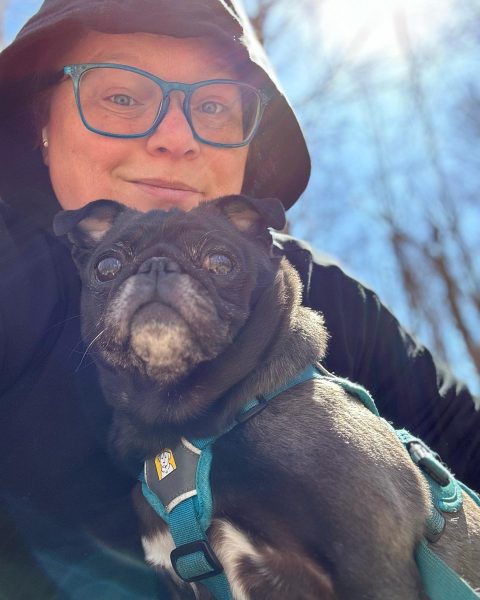Go-Pros, Backpacks and strollers
Throughout the summer of 2016, scores of mothers from Lamoille, Washington and Chittenden County could be found taking their infants for a series of eight-minute walks. Some of these children were buckled into backpacks, others nestled into strollers, but all could be seen sporting a small black GoPro strapped to their foreheads.
Each mother, accessorized with similar headgear, was part of a study carried out by Johnson State College’s Gina Mireault, professor and co-chair of the behavioral sciences department. Mireault has spent several years analyzing the development of infant humor, and this particular study became an easy offshoot of her other projects. This time around, Mireault sought to unravel the different experiences of the travelling infant and discover which transport method, a backpack or a stroller, provided more opportunities for learning.
“The idea wasn’t really to see what infants prefer,” Mireault said. “Really, we’re looking to see if there are differences between backpacks and strollers in relation to language, one of the big indicators of psychological development. That’s why I was interested in this study. I thought it would be a really pragmatic way to boost infant language opportunities.”
The idea that sparked this study originated from personal experience. When Mireault’s children were infants, she noted they often fell asleep when pushed about in a stroller but were wiggly and chatty when carried in a backpack. “I noticed the difference,” she said, “and it made me curious. That’s the occupational hazard of being a scientist.”
An opportunity for the study did not present itself until much later, when Mireault picked up a pair of GoPros for a discount price in the fall of 2015, and these mounted cameras seemed the perfect device for her study. “We wouldn’t be part of the walk,” she said, “but we’d have the audio and video of the experience. We’d see how the experience was shared.”
To find participants for these walks, Mireault reached out to the Vermont Department of Health, an organization that contains many public birth records. “You can sort through the birth records and find babies in the age range you’re looking for by backdating,” she said. In this case, Mireault worked to recruit mothers whose infants were between 6 to 9 months old. These mothers were contacted via pamphlet.
Mireault quickly recruited two of her students for the job: Brenna Laughlin and Brady Rainville. Laughlin, a vital part of the data collection and resulting analysis, recently graduated from the psychology department.
Rainville, a senior majoring in both psychology and business, had collaborated with Mireault on two other research projects before embarking on this one. “Being part of the studies let me see how research was done,” Rainville said. “I wasn’t just inputting data into a file. I was actually there from the beginning, talking with Gina about our questions, formulating our hypotheses and figuring out how we were going to measure everything.” This field work was a vital way for Rainville to gain research experience, a process that can be as meticulous as it is rewarding.
In this case, the study involved analyzing each recorded video by hand, second-by-second, with a special attention to any vocalizations made by either the parent or the infant. This process, known as coding, took a considerable amount of time after the videos were recorded and uploaded. Of particular note were the length of each vocalization, as well as who initiated the “conversation.”
“All of the studies I’ve worked on with Gina are novel, and no one has done this particular GoPro study before,” Rainville said. “We couldn’t use a sheet to measure vocalizations, and we came up with this whole process that we thought was going to be perfect. After the first video took an hour to code, we realized we couldn’t spend that much time on each one. We had to go back and figure out a quicker way to mark when the vocalizations were occurring. It added additional time, but it was definitely worth it.”
Mireault, meanwhile, is all too familiar with the struggles of coding infant behavior. “All infant studies are very labor intensive since infants can’t talk,” she said. “Coding takes a long time, and students are already busy. They’re working while taking five classes; Breanna was on the volleyball team, and Brady does a bajillion other things. To their credit, they completed enough data analysis that I could submit the findings to the Eastern Psychological Association. They were coding through the summer, and data they collected in June would be coded in July while they were simultaneously collecting more data.”
Rainville was equally impressed with the efficiency of the work. “When we first came up with the idea, I thought it was going to take a really long time,” he said. “Bre and I worked really well to get it all done. She scored our questionnaires, and I uploaded everything to our computer before we both watched.”
These questionnaires served as a vital part of the pre-research process, as most parents noted their children seemed more engaged in the world when viewing it from a backpack. The data that Rainville and Laughlin collected not only corroborated this observation but found a statistically significant difference in the frequency of an infant’s interaction with their parent, in terms of both touch and babble talk.
“A backpack is a greater social experience,” Mireault said. “Parents touched their babies more, both were much more talkative, and unfamiliar people approached them more often to talk. All of this is important to language development, and language is one of the big indicators of later cognitive outcomes. When the baby’s in a stroller, there isn’t that much interaction. When you put them in a backpack, interaction just sort of happens by default. You don’t have to be on a walk. You can use it in the grocery store, on Church Street, whatever you’re doing. Just pop them in the backpack.”
Mireault, Rainville and Laughlin’s findings will be presented at several national psychological conferences in the coming months. Of these personations, Rainville noted: “Many peers were impressed that we were able to see such significant differences between the two experiences. Overall, the scientific community has had a positive reception to our project and feels our research is novel, unique and creative.”
Some of their findings may be found on their related Facebook page, Infant Laughter Project at Johnson State College.
Josh LeMay joined the Basement Medicine staff in Spring 2014, assuming the role of staff reporter.





